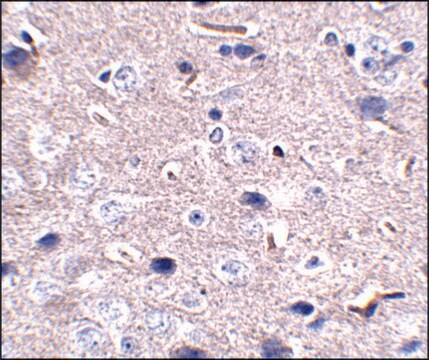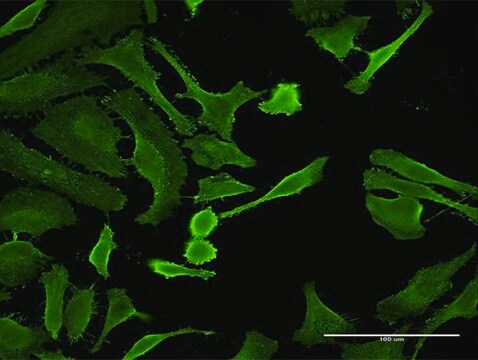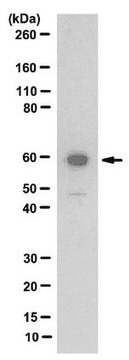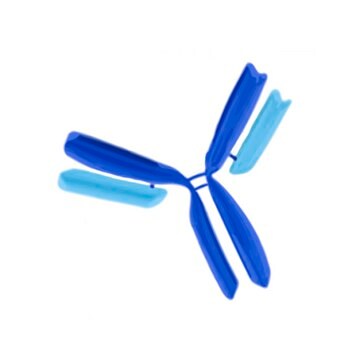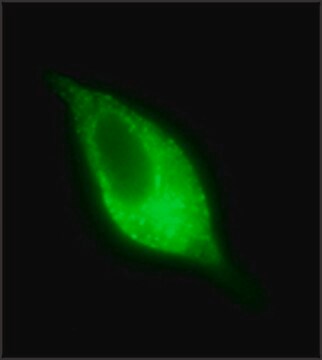C9979
Monoclonal Anti-CD152 antibody produced in mouse
~1 mg/mL, clone AS32, purified immunoglobulin, buffered aqueous solution
Synonim(y):
Anti-CTLA-4
Zaloguj sięWyświetlanie cen organizacyjnych i kontraktowych
About This Item
Polecane produkty
pochodzenie biologiczne
mouse
Poziom jakości
białko sprzężone
unconjugated
forma przeciwciała
purified immunoglobulin
rodzaj przeciwciała
primary antibodies
klon
AS32, monoclonal
Formularz
buffered aqueous solution
reaktywność gatunkowa
human
stężenie
~1 mg/mL
metody
neutralization: suitable
western blot: suitable
izotyp
IgG1
numer dostępu UniProt
Warunki transportu
wet ice
temp. przechowywania
2-8°C
docelowa modyfikacja potranslacyjna
unmodified
informacje o genach
human ... CTLA4(1493)
Opis ogólny
CD152 jest strukturalnie podobny do CD28 i należy do nadrodziny genów immunoglobin (Ig). Gen kodujący ludzką CD152 znajduje się na chromosonie 2. Składa się z pojedynczej domeny zewnątrzkomórkowej podobnej do Ig V, domeny transbłonowej i domeny wewnątrzkomórkowej. Ulega ekspresji głównie przez cytotoksyczne limfocyty T, a poziom ekspresji jest zależny od aktywacji.
Immunogen
rekombinowana zewnątrzkomórkowa domena ludzkiego CD152.
Zastosowanie
Monoklonalne przeciwciało anty-CD152 produkowane na myszach jest odpowiednie do western blottingu i badań neutralizacji, w których wykazano, że przeciwciało to blokuje interakcję rozpuszczalnego ludzkiego CD152 z ludzkim CD80.
Działania biochem./fizjol.
CD152 i CD28 wraz ze swoimi ligandami stanowią jeden z dominujących szlaków ko-stymulacyjnych, które regulują odpowiedzi komórek T i B. CD152 działa jako cząsteczka współstymulująca w wywoływaniu pomocy komórek T podczas prezentacji antygenu i działa jako negatywny regulator aktywacji komórek T.
Opis wartości docelowych
CD152, glikoproteina powierzchniowa komórek, jest jednym z dwóch ligandów (drugim jest CD28) dla CD80 (B7-1) i CD86 (B7-2). Wydaje się, że ta interakcja działa jako negatywny regulator aktywacji komórek T. CD152 ulega przejściowej ekspresji na aktywowanych limfocytach T.
Postać fizyczna
Roztwór w 0,01 M soli fizjologicznej buforowanej fosforanami, pH 7,4, zawierający 0,08% azydku sodu.
Uwaga dotycząca przygotowania
Przygotowany z supernatantu hodowli tkankowej, oczyszczony przy użyciu białka G.
Oświadczenie o zrzeczeniu się odpowiedzialności
O ile nie określono inaczej w naszym katalogu lub innej dokumentacji firmy dołączonej do produktu(-ów), nasze produkty są przeznaczone wyłącznie do użytku badawczego i nie mogą być wykorzystywane do żadnych innych celów, w tym między innymi do nieautoryzowanych zastosowań komercyjnych, zastosowań diagnostycznych in vitro, zastosowań terapeutycznych ex vivo lub in vivo lub jakiegokolwiek rodzaju konsumpcji lub zastosowania u ludzi lub zwierząt.
Ta strona może zawierać tekst przetłumaczony maszynowo.
Nie możesz znaleźć właściwego produktu?
Wypróbuj nasz Narzędzie selektora produktów.
Kod klasy składowania
10 - Combustible liquids
Klasa zagrożenia wodnego (WGK)
WGK 2
Temperatura zapłonu (°F)
Not applicable
Temperatura zapłonu (°C)
Not applicable
Wybierz jedną z najnowszych wersji:
Masz już ten produkt?
Dokumenty związane z niedawno zakupionymi produktami zostały zamieszczone w Bibliotece dokumentów.
Yasuhiro Shimojima et al.
Modern rheumatology, 27(1), 102-109 (2016-05-05)
We investigated the characteristics of circulating T-helper (Th) cells and CD4 Peripheral blood samples were obtained from 14 patients with PAN. Nine patients having granulomatosis with polyangiitis (GPA) and 11 healthy individuals (HC) were enrolled as controls. Th cells and
T Lindsten et al.
Journal of immunology (Baltimore, Md. : 1950), 151(7), 3489-3499 (1993-10-01)
CTLA-4 is an adhesion receptor expressed on activated T cells. The amino acid sequence of CTLA-4 is related to CD28, and although the function of CTLA-4 remains unknown, it shares several features with CD28, including a common counter-receptor, B7, that
N J Karandikar et al.
The Journal of experimental medicine, 184(2), 783-788 (1996-08-01)
CTLA-4, a CD28 homologue expressed on activated T cells, binds with high affinity to the CD28 ligands, B7-1 (CD80) and B7-2 (CD86). This study was designed to examine the role of CTLA-4 in regulating autoimmune disease. Murine relapsing-remitting experimental autoimmune
M Murakami et al.
Proceedings of the National Academy of Sciences of the United States of America, 93(15), 7838-7842 (1996-07-23)
To determine whether alternative cytotoxic T lymphocyte-associated protein 4 (CTLA4) binding proteins exist on B cells, we constructed (i) mCTLA4hIgG consisting of the extracellular region of a mouse CTLA4 molecule and the Fc portion of a human IgG1 molecule and
Danbee Ha et al.
Proceedings of the National Academy of Sciences of the United States of America, 116(2), 609-618 (2018-12-28)
Anti-CTLA-4 mAb is efficacious in enhancing tumor immunity in humans. CTLA-4 is expressed by conventional T cells upon activation and by naturally occurring FOXP3+CD4+ Treg cells constitutively, raising a question of how anti-CTLA-4 mAb can differentially control these functionally opposing
Nasz zespół naukowców ma doświadczenie we wszystkich obszarach badań, w tym w naukach przyrodniczych, materiałoznawstwie, syntezie chemicznej, chromatografii, analityce i wielu innych dziedzinach.
Skontaktuj się z zespołem ds. pomocy technicznej